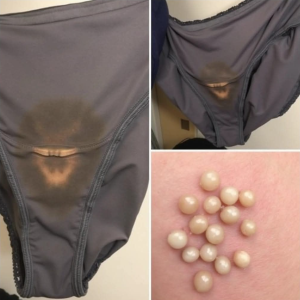 The phrase “BE CAREFUL, if you notice this in your underwear, it means you have Ca…” is a classic example of clickbait health warnings that often circulate online to grab attention by implying you may have cancer or another serious illness based on vague symptoms. Let’s break it down responsibly and give you real, accurate medical insight—not fear-mongering.
The phrase “BE CAREFUL, if you notice this in your underwear, it means you have Ca…” is a classic example of clickbait health warnings that often circulate online to grab attention by implying you may have cancer or another serious illness based on vague symptoms. Let’s break it down responsibly and give you real, accurate medical insight—not fear-mongering.
⚠️ What You Notice in Your Underwear: What It Actually Could Mean
Seeing something unusual in your underwear—like blood, discharge, stains, or wetness—can be alarming. But it doesn’t automatically mean “you have cancer.” Here’s a look at what to watch for, what it might mean, and when to see a doctor.
🔴 1. Blood (When You’re Not on Your Period)
Possible causes:
-
Spotting from ovulation or hormonal changes
-
Implantation bleeding (early pregnancy)
-
Infection (e.g., STIs, yeast)
-
Cervical polyps
-
Perimenopause changes
-
Cervical or uterine cancer (less common, but serious)
📌 When to worry:
If the bleeding is:
-
Frequent
-
Post-menopausal
-
After sex
-
Accompanied by pain or discharge
You should talk to a doctor.
🟡 2. Unusual Vaginal Discharge
Normal discharge is clear to white, sometimes a little yellowish when dry. It may vary with your cycle.
Abnormal signs:
-
Green, gray, or thick yellow
-
Foul or fishy odor
-
Itchy, burning, or painful
-
Bloody or pink
📌 Possible causes:
-
Yeast infection
-
Bacterial vaginosis
-
Trichomoniasis
-
STIs like gonorrhea or chlamydia
-
Cervical cancer (rare but possible if discharge is bloody or watery and persistent)
🔵 3. Wetness or Urine-Like Spots
This could be from:
-
Vaginal discharge
-
Urinary incontinence
-
Sweat
-
Ovulation fluid
-
Amniotic fluid (if pregnant)
📌 Not usually a cancer sign, but if it’s persistent wetness with no clear cause, seek medical evaluation.
⚫ 4. Dark or Rust-Colored Spots
If you see brown, rusty, or black spots, it could be:
-
Old blood from spotting
-
Endometrial tissue (if you have endometriosis)
-
Breakthrough bleeding from birth control
-
Cancer warning signs (if accompanied by weight loss, pelvic pain, or occurs in post-menopause)
✅ What to Do If You Notice Something
Step 1: Stay Calm
Most changes are caused by hormones, infections, or lifestyle—not cancer.
Step 2: Track It
Write down:
-
Color
-
Smell
-
Texture
-
Timing in your cycle
-
Frequency
Step 3: Get Checked If You Notice:
-
Bleeding after sex
-
Persistent spotting outside your period
-
Strong-smelling or green discharge
-
Pelvic pain
-
Bleeding after menopause
🧬 So… Does “This in Your Underwear” = Cancer?
No. Not automatically.
That type of vague scare tactic is misleading and can cause unnecessary fear.
But your underwear can be a useful clue to your reproductive or urinary health. That’s why doctors ask about these symptoms—because they can catch infections, hormonal imbalances, and yes, sometimes early signs of gynecologic cancer.
🔎 When It Could Be Cancer
Cancers of the reproductive system (like cervical, endometrial, or vaginal) might show up through:
-
Watery or bloody discharge
-
Bleeding outside your period
-
Painful sex
-
Pelvic pressure or back pain
-
Unexpected weight loss
📞 Call a doctor if you notice those symptoms, especially if you’re over 40 or post-menopausal.
🚫 Don’t Fall for Clickbait
Many headlines like:
-
“What this color in your underwear means…”
-
“Women are ignoring this deadly sign…”
-
“If you see this, it’s already too late…”
…are designed to scare you into clicking, not educate you.
✅ Final Thoughts
Your underwear can tell you a lot — but it doesn’t tell you everything. If something seems off, trust your instincts, stay calm, and get medical advice. Early detection is key for many conditions, and it’s always better to ask a doctor than rely on viral fear posts.


